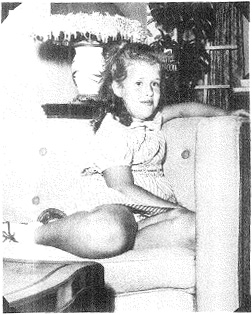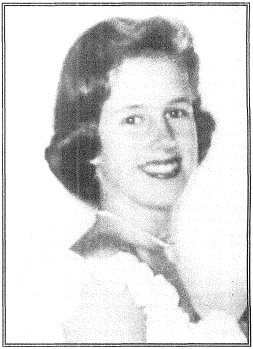
Fat
In the early fifties, my father got a pay raise, so we moved from our small, rented San Francisco house to a larger, two-story home in the suburbs. Palo Alto, home of Stanford University, was a college town that provided a safe and proper environment for bringing up well-adjusted (?) children. Suddenly, we were right in the middle of the WASP caricature of family life, complete with two children, a two-story house, a two-car garage, and the promise of many more “well-adjustments” on the horizon.
I didn't mind our move as much as I minded my parents selling our old black 1938 Buick, my fat friend that lived in the garage. They just went and sold it—the car that had faithfully transported us since I was born. Although crying was something I rarely indulged in (I usually got either quietly annoyed or verbally abusive), tears flowed for my intimate four-tired friend. I was sure that cars had feelings. It just seemed such a betrayal that a 1949 two-tone gray Oldsmobile was now usurping the Buick's position as a member of the family.
Still, Palo Alto was interesting enough—not exactly Barnum and Bailey, but for a ten-year-old, it was at least accommodating. Unlike in hilly San Francisco, the roads here were flat and you could ride a bicycle all day and not get tired. And was it peaceful. For the first time, I could pretty much go anywhere I wanted and my mother didn't have to worry.
I was rarely alone, though. I met two girls several days after we moved in who would be my pals for the next couple of years. They were into a more athletic style of play than I ordinarily favored, but since neither suggested going to a museum and I wanted to have friends, I took up handstands, cartwheels, hide and seek, swimming, and roller skating. Unconsciously, I was beginning to learn about social groups and the hierarchies that inevitably sprung from them. There were the cool guys and the nerds, and I quickly realized that I was going to have to shed the nerd cocoon if I wanted to be part of the pack.
It was time to start letting go of individuality. Lose the art books, get into Marvel Man comics, take off the saddle shoes and get some flats, never mind Chopin, check out Chuck Berry, adults are a drag, kids rule. Are you too fat? Is your hair the right style? Here it comes: the big teenage mold. The big question was: DO I FIT IN?
And then there were boys. In 1950, when I was ten, Jerry Slick, one of my neighbors, was in my sixth-grade class. I thought he was a dufus with his round face and glasses, but then, in 1961, I married him.
So much for the judgments of a ten-year-old.
Now Red Hendricks—he was another story. He was cool and dangerous, a member of the “fighting Irish,” with a knocked-out front tooth, a greased-up fifties pompadour, and a heavy attitude under a black leather jacket. Too bad I was a fat dufus myself. He wasn't interested.

Fat blonde doing a Sharon Stone exhibition: me at nine. (Ivan Wing)
I remember another kid, named Ricky Belli (his dad was Melvin Belli, one of San Francisco's flashiest lawyers), who lived down the street. He and my friend Susan used to make out in his garage. Did they go all the way? She said no, he said yes. But no one pulled me into any garage fun. There were no debates about whether I had gone all the way. No one raced after me when the kissing games began.
Something was wrong with my picture: braces and fat, for starters.
I arrived on the first day of class at Jordan Junior High School, wearing the wrong clothes and the wrong hairdo, with the wrong binder and a complete lack of teenage skills. But I did notice the girl with the blonde hair, big smile, big boobs, long legs, and cool outfit. She's the one, I thought. It was Darlene Ermacoff. I knew she'd graduated from one of the other grammar schools closer to the center of town, where the kids were more sophisticated. Her boyfriend, Johnny Schwartz, was good-looking, dark haired, and slender with a great smile, and his father, “Marchie” Schwartz, was the Stanford football coach. When I watched Darlene and Johnny strolling by, I knew I was looking at high school royalty—the king and queen of the prom. So I got the clothes, the shoes, the binder, and the hang of the way to talk. And since I was blonde, I figured as soon as puberty kicked in, Darlene and I would be neck and neck in the Barbie doll marathon.
But something went wrong. At thirteen years old, my hair turned fuzzy dark brown, the large boobs never materialized, and after the weight dropped off, I was nothing more than a skinny, sarcastic, dark-haired basketball cheerleader. What I didn't appreciate at the time was the wonderful workout a woman's imagination gets when she can't rely on her looks to make it all happen. She has to be ready for contingencies, and she knows that any acceptance she does get is a compliment to her creative ability, not her genetic code.

Smiling through the transition: me at thirteen. (Ivan Wing)
But that “silver lining” didn't mean shit in high school.
Darlene was one of those girls who had it all: good code, good humor, and a good mind. We became friends, anyway, and a couple of months ago when she was staying at my house for a few days, I asked her why she'd stooped to hang out with my nerdy self. We were laughing about the phases, the years, the mistakes, the boys/men, the death-defying drug use, the whole diary, and she said she'd thought that I was the pretty one, the clever one, and so forth. If only I'd known that in 1952. I don't remember feeling like a total loss back then, but until I was about twenty-four and saw myself as a social steamroller, there was always this intangible next step that needed to be taken to feel like I had the situation locked.
A step I could never quite manage.
So having become at least a second-string member of the ruling social class at junior high, I let the family flag of sarcasm fly in all directions. I figured my mouth was all I had, that my sarcasm was my way in with the popular girls. And everything seemed to be going relatively well, until the night of my fourteenth birthday. I was at home, celebrating with my family, when my girlfriends called me up. I ran to the phone excited, figuring they wanted to wish me a happy birthday. Instead, they told me that my lack of consideration for other people's feelings—aka sarcasm—had led them to the decision to drop me from the group.
No friends?
Tears. My mother had a diamond ring I'd always loved, and when she saw my sadness, she gave me the ring in an attempt to snap me out of it. Diamonds as a substitute for friends? The ring did nothing to cheer me up, and I realized that this bauble I'd coveted for so many years was now nothing more than metal and minerals.
Did I learn anything from the experience? Not really. People are only occasionally more important than metal, minerals, black humor, and cars.
Stubborn.